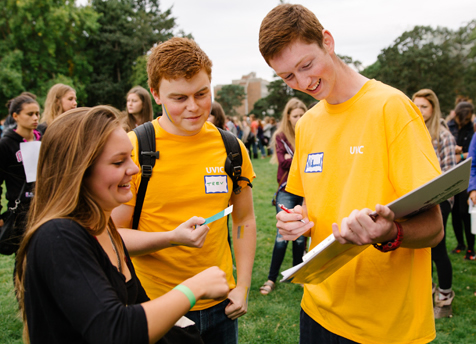The power of memorials: Finishing up our field school
Guest post series: I-Witness Field School
 The I-Witness Holocaust field school (GMST 489) explores the ways in which the Holocaust is memorialized in Central Europe.
The I-Witness Holocaust field school (GMST 489) explores the ways in which the Holocaust is memorialized in Central Europe.
- Learn more about the course and instructor: Field school a chance for students to witness Holocaust legacy.
- Follow the field school on Twitter.
- Read the field school blog.
Day 18: Something You Can’t Avoid
Guest post by Riley van der Linden
Wandering around downtown Budapest this morning really took me by surprise. With our first morning in a city that is very quickly becoming my favourite of the five we have been able to visit on this field school, I was given a much needed opportunity to not only sleep in, but also to think. And even though I was giving myself the off time to think about trivial things, the nature of this course means that its content is never far from my mind.
I was fully aware of this when trying to make my way back to the hostel in a timely fashion for the afternoon’s walking tours and class session. Looking like a flustered tourist with my big city map in front of me, I was spending a lot of time looking at the ground.
It was then that I saw my first Hungarian stolperstein.
Immediately, I began to think about the story of this individual person. While I could not read the majority of the stone due to my lack of knowledge of the Hungarian language, one word I did understand: Auschwitz.
The remainder of the walk back to our hostel was spent thinking about this person. I was confronted with a reminder of the history that lives and breathes in these streets without even intending to. The personalization of the memorial stone made the events of the Holocaust in Hungary suddenly very real. This is a country with a different relation to the war and to the Shoah, but it still affects human beings on a personal level in a very similar way to the other countries we have visited.
The stumbling stone was on my mind as we visited the Shoes on the Danube, a memorial that commemorates the victims who lost their lives to the Arrow Cross between 1944 and 1945 along the Danube River. This memorial has no mention of not only an individual person represented by one of the sixty pairs of shoes along the river, but it does not even mention any specific group of people who were murdered in this way. Such a vague memorial but also very specific in itself.
This exact question was brought up in our classroom session later that day. We talked a lot about personal monuments that memorialize one or a small group of people in comparison to many of these larger monuments that give no specific names, or in the case of the Nameless Library in Vienna, work because they produce no specific details.
I think what I took from this is that it depends on the person viewing the site. So many of my classmates found monuments to be more effective when they were confronted with a specific name and details about this person; it made the events of the Holocaust seem to be very real. Meanwhile, myself and others found the larger scales ones to be more effective because they emphasize the sheer volume of the genocide itself.
The remainder of the afternoon was spent on a short tour of Liberty Square, an interesting space as it addresses both the Soviet, Nazi, and Hungarian roles in the Holocaust and afterwards. The space is still a place of controversy, as there is one monument that was protested even before construction had started.
All of this just goes to show that memorialization is a tricky topic. How do you go about doing it effectively? How do you make it historically accurate and without biases? How do we force people to engage with a past that many try to avoid? Questions to consider as we finish our last few days of field school.
Shout out to my fam-jam back home, and to everyone else reading this blog!





